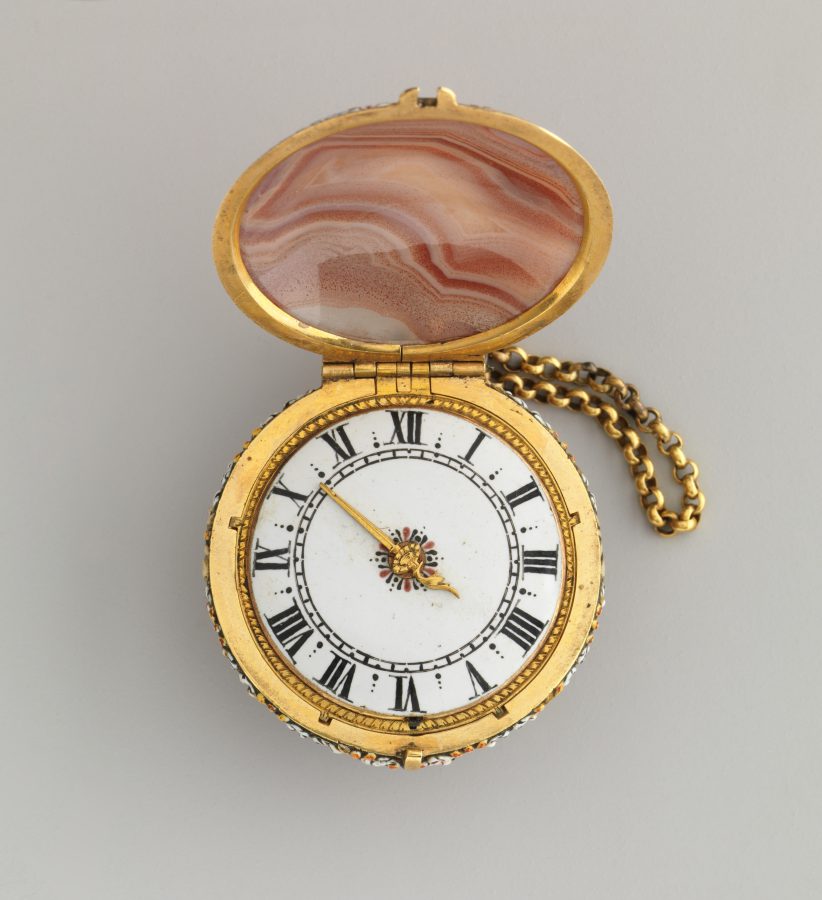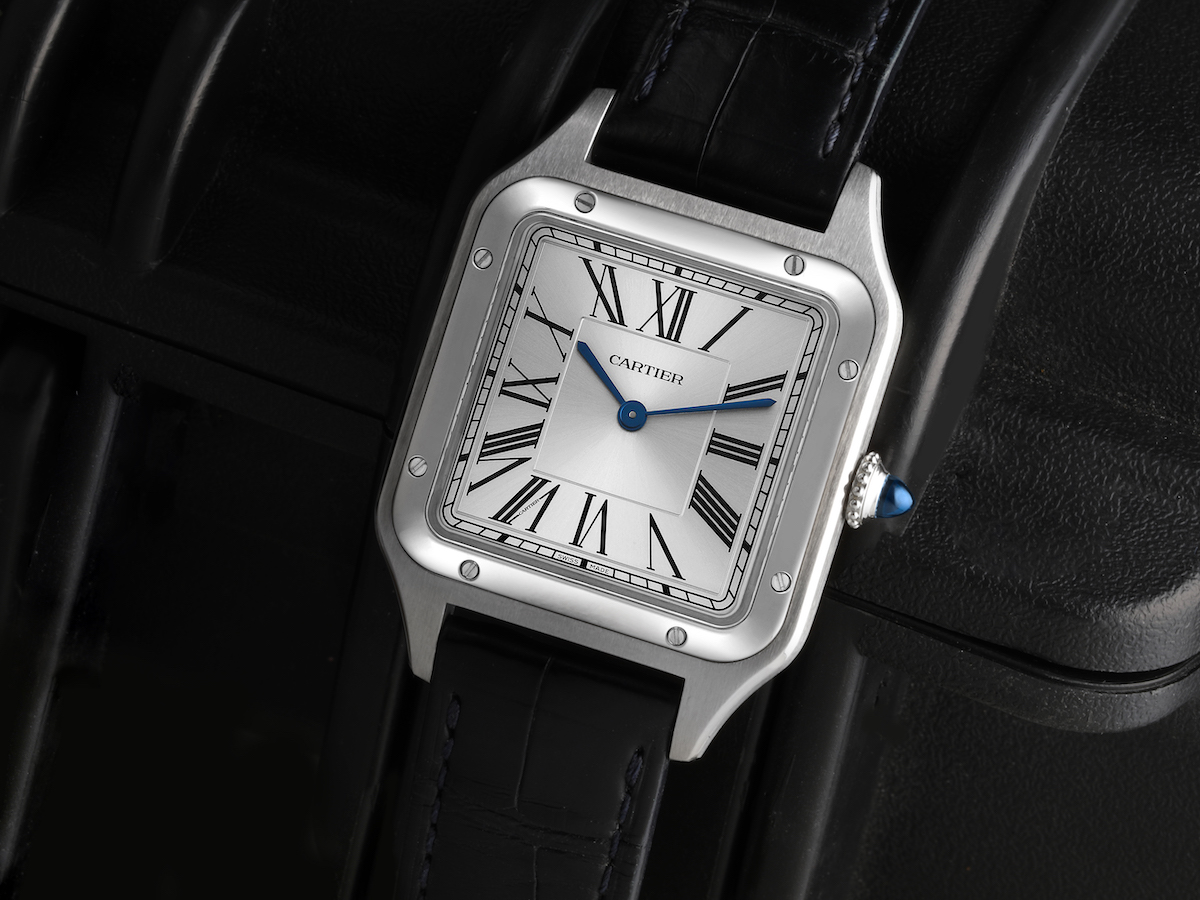From sundials to track the sun’s movements, to candles that burn at a very particular rate, people throughout history have always been finding unique and interesting ways to track time. The evolution of timekeeping devices reflects not only the need for practical time measurement but also the cultural and technological developments of each era.
With the advent of the first mechanical movement in the 1200s, the history leading to the first wristwatch is just as important as the wristwatch itself. Let’s explore the history of the wristwatch, and how each era contributed to the rich tapestry of history that surrounds it, shaping it into the iconic accessory we know today.
<>
The very first mechanical watches

Salisbury Cathedral in England was the first place to have a mechanical device to track time in 1275. The church was often the place of invention when it came to tracking time, as their lives revolved around prayer and song at intervals throughout the day. This mechanical timekeeper didn’t have any dial or face as we would recognize it today, but was a simple tracker of minutes.
In the 13- and 1400s, there weren’t actual watchmakers. Clocks or timekeepers were part of the art of the blacksmith. Bells would chime the minutes or hours to be heard rather than read off a dial. The first pocket watch wasn’t referenced until 1462 and it was called a pocket clock.
<>
From pocket watches to wristwatches
Pocket watches

By the mid-1500s the Swiss watch industry was born, almost under duress. Calvinists banned the wearing of any jewelry, so to save the brass, bronze, and silver industry, jewelers learned to make watches, and shortly the wearing of a pocket watch was an integral part of a man’s wardrobe.
The first iterations only showed the hour until the minute hand was added in 1680, and they weren’t really pocket watches, but rather something they’d wear on a chain around their necks. The pocket forms didn’t come around until the waistcoat became popular thanks to Charles II of England.
Wristwatches were simply not popular and rarely seen. It wasn’t until they rose in popularity due to women’s fashion that the wristwatch rose to fame.
<>

Puritan watches
While the previous centuries saw the advent of elaborate timepieces, the 17th century ushered the entry of “puritan watches”. Originating in England, these refer to plain, almost egg-shaped watches, which are believed to have been developed as a more simple and understated alternative.
During the same period, Puritan watches were also manufactured in the Dutch cities of Haarlem and The Hague. Although information on the specific features and traits of Puritan watches is scarce, vintage models can still be purchased online, with many showcasing metal bands and a variety of dial designs.
<>
Wristwatches

As far as history knows, the very first wristwatch was designed for the Queen Caroline Murat of Naples in 1810 by Abraham-Louis Breguet. This led to a more modern model. At this time, while men kept their watches on a chain attached to their pocket, women were still wearing them on chains around their necks.
Patek Philippe, another popular name in luxury watches, designed a bracelet watch for the Countess Koscowicz of Hungary in 1868.
<>
Reine de Naples

The name “Reine de Naples” means Queen of Naples. The oblong repeater for the wrist that Breguet designed for the Queen led to the development of a modern model entitled the Reine De Naples.
<>
Cartier Santos

It became apparent that despite the accuracy of the pocket watch improving drastically during this time period, it became more and more impractical to always have to pull your timepiece out of your pocket.
This concept was expressed loudly by the pilot Alberto Santos Dumont as he wished to be able to check the time while keeping both hands in use while flying. As such, his friend, the famous Louis Cartier designed him the Cartier Santos-Dumont in 1904. Simultaneously, the first men’s wristwatch was born as well as the first pilot’s watch.
With the outbreak of the World Wars, the idea of pulling your watch out of your pocket fell almost completely out of use. You can see the effects of the massive military presence during the advent of the men’s wristwatch in the additional features that are placed into each timepiece — from rotating slide rule bezels to readability in low-light conditions.
<>
Automatic watches

During the 1920s you’ll find the advent of the automatic movements with their self-winding watches. By 1926, Rolex had already introduced their waterproof Oyster case and by 1931 the Oyster Perpetual waterproof and self-winding Rolex was released.
Automatic watches are a type of watch that uses a rotor to wind the mainspring. The rotor, which is made up of a weight that turns with the movement of your wrist, winds the mainspring when it is moved by your arm. Automatic watches can also be wound manually using an attached crown on top of the case (this is known as ‘hand-winding’).
<>
The Quartz Crisis

By the 1970s the watch market expanded once again to include quartz powered watches that needed no winding. The first of these watches was the Seiko Astron in 1969.
Quartz watch movements quickly fell in price as there were far fewer moving parts and cheaper to make. This caused a crisis for the makers of mechanical and automatic watches as the market was flooded with these much cheaper versions. It was a struggle and many smaller manufacturers disappeared entirely.
By 1970, only 600 of the 1600 watchmaking companies survived. Even immensely successful companies like Rolex struggled and eventually released their own Quartz movements to compete with the market.
<>
The Renaissance of Mechanical Watches

This Quartz crisis lasted for almost two decades before mechanical watches came to the forefront again. The functionality and craftsmanship of mechanically operated wristwatches, and the increased accuracy and new movements helped bring them back to popularity.
The luxury watch world played a pivotal role in reviving the appeal of mechanically operated wristwatches. Luxury watchmakers focused on emphasizing the craftsmanship, artistry, and tradition intrinsic to mechanical watches. They also highlighted the intricate movements, meticulous hand-finishing, and timeless design elements that set mechanical watches apart as objects of beauty and engineering excellence.

In addition to emphasizing the aesthetic and artisanal aspects of mechanical watches, watchmakers introduced new and innovative movements to enhance the functionality and desirability of these timepieces.
As a result of these efforts, mechanical watches regained popularity among enthusiasts and collectors, leading to a renaissance of interest in traditional timepieces. The return of interest in mechanical watches not only rekindled an appreciation for the art and craftsmanship of watchmaking, but also strengthened the position of mechanical watches in the market, with a growing appreciation for their intrinsic value, historical significance, and the emotional connection they evoke in their owners.
<>

Smartwatches
Equipped with touchscreens, built-in sensors, and applications that can do anything from telling time to making phone calls and sending emails, smartphones have become ubiquitous in today’s everyday life. With features and functionalities similar to that of a smartphone, smartwatches like Garmin, Fitbit, and the Apple Watch have become increasingly popular.
Overall, smartwatches are a versatile piece of wearable technology that offer convenience and functionality on the go. However, as advanced as they are, they do have drawbacks such as limited battery life, and software obsolescence over time as technology advances.
On the other hand, mechanical timepieces, especially luxury mechanical watches, are renowned for their longevity, high resale values, and timeless appeal, therefore offering a more enduring investment.
<>
The Invention of the Wristwatch: Final Thoughts
The wristwatch is indeed a remarkable invention that often goes underappreciated. When we delve into the history of the wristwatch, it becomes evident that its development required significant innovation and creativity. From the earliest mechanical timepieces to the modern, high-tech watches, the evolution of wristwatches has been shaped by centuries of craftsmanship and ingenuity.
If you’re interested in owning a piece of this rich history, SwissWatchExpo offers a vast selection of nearly 3,000 timepieces from the world’s best brands. Explore our vast selection of authentic, pre-owned watches at SwissWatchExpo.com.
<>


